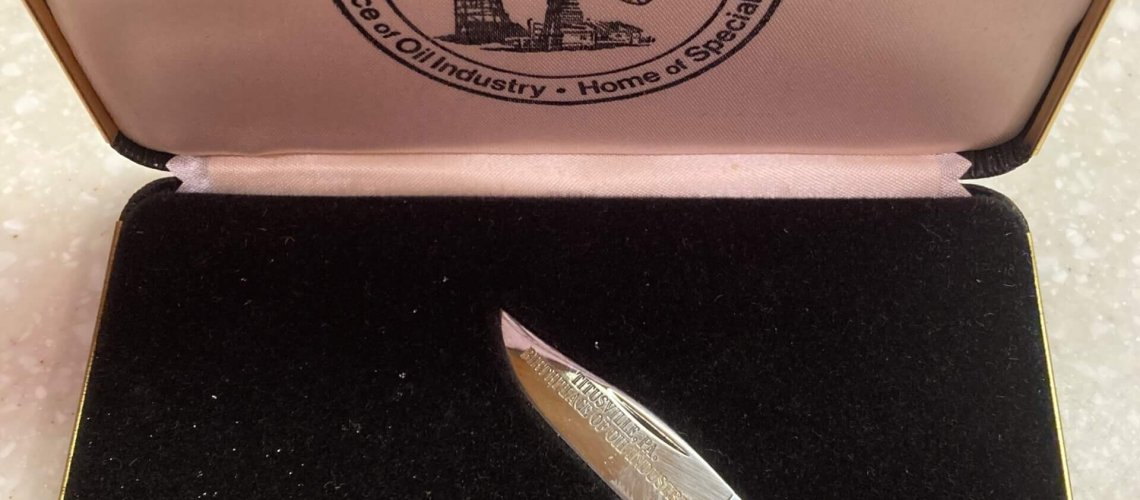
Dan Lago 1-5-2024
I’d like to gratefully acknowledge the photographs Fred and Linda Fisher contributed to this article and the many years of previous, very informative conversations about Queen lockback knives that I have shared with them. Also gratefully acknowledge the photo by Brian Guth for an SFO knife image.
Introduction
Queen has made only one pattern for its smallest lockback knives, using the same frame for all versions since first offering the “minute Man” in 1980. These knives are listed in the various catalogs as 2 7/8” or in latter issues 3.0” closed with usually a clip blade of 2 1/8”. A total length of just under or over 5 inches makes them a “small lockblade” in our opinion. The handle allows a-three finger grip, with a large indent for the first finger, while the cap end is nestled in the middle of your palm. These blades are thin (less than 1/16”) and flat ground to a well sharpened edge. They slice and cut very well, but should not be regularly used for heavier tasks. There are other larger knives for those tasks.
We have covered other lockbacks Queen produced that are larger and were more popular with customers, but these knives have survived in Queen catalogs for almost 40 years and been offered in many different forms. (Please see our Reference list for other lockback articles.)
If you like a small lockblade that rides easy in your pocket, these will please you. You need to be patient in finding these knives. They are not as easy to find in today’s secondary markets, but because of their small size, they often were left in drawers and they often found in very good shape, or used up in very poor condition. You have to judge.
Review of Queen small Lockback knives.
There are 16 knives included in this review, reflecting the fact that they have not been a dominant theme in the company’s production, and our own interests have been for larger knives. We generally proceed in chronological fashion, beginning in 1980.
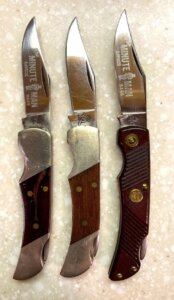
Figure 1. The Minute Man was offered in Queen catalogs for 21 years, 1980-2001, (with a two-year lapse in Queen worst years, 1985-86). The knife on the left is dated 1982, but shows a darker handle with a repair filling a crack; We have no idea if the factory or an owner made that repair, but for our purposes, it shows a good image of the blade etch. The middle knife in Figure 1, does not have an etch and shows little polishing to smooth the edges of the handle. The pile side shows some damage in placing handle pins. It may have been sold as a “second.” However, it does show a medium, light brown staminawood handle which is more characteristic of early Rawhide knives. The Rawhide on the right in Figure 1, is from 1995 and shows design changes in the last years for the pattern. It is built with a “fisheye” pin left a bit proud (a “big pin”) no larger top bolster is used, and wood covers the whole frame. The grooves give more grip and a brass shield is attached. The knife is thinner and a bit longer. Compare the two on the left for the 2 7/8” and the right hand dark Rawhide for the 3” length. This knife feels a little better in the hand and was used for all wooden handle versions of the pattern (see Figure 12). Figure 2, shows a catalog page for 1999, with a similar small lockback Rawhide in light Oak stabilized wood At the far left.
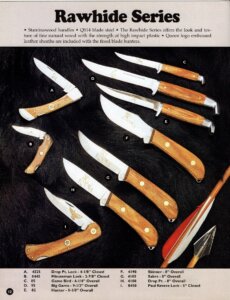
Figure 2, Queen Catalog, 1999, page 12, Rawhide collection in light Oak, with some using Bird etches, first used in the earlier Hawk Series. See #8445, “minuteman” small lockback at the left side.
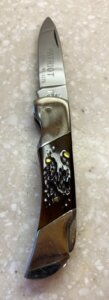 Figure 3. “The Patriot” (Model #1175) was made only in 1987-1988 when Queen returned to using bone jigged covers on its knives (based largely on skill gained while working on John Primble and Winchester knives for Blue Grass Cutlery and the collector market.) The pattern is exactly the same as the Minute Man in the Rawhide series, but this knife had a spear blade, different etch with name change.
Figure 3. “The Patriot” (Model #1175) was made only in 1987-1988 when Queen returned to using bone jigged covers on its knives (based largely on skill gained while working on John Primble and Winchester knives for Blue Grass Cutlery and the collector market.) The pattern is exactly the same as the Minute Man in the Rawhide series, but this knife had a spear blade, different etch with name change.
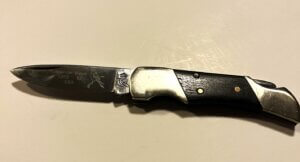 Figure 4. The “Sparrow Hawk” (Model; #1200) with black stabilized wood built on exactly the same frame as the Rawhide Minuteman knife. Unlike the Minuteman, it featured an etched, spear point blade. This knife was offered from 1982 till 1992, (again with the same gap in 1985-86 for Queen’s terrible downturn), for a total of eight catalog years. In our opinion, these knives were a bit more polished, a bit more attractive with black handle, and had cooler names, but they did not have the longevity of the Rawhide Series. (Photo by Fred and Linda Fisher).
Figure 4. The “Sparrow Hawk” (Model; #1200) with black stabilized wood built on exactly the same frame as the Rawhide Minuteman knife. Unlike the Minuteman, it featured an etched, spear point blade. This knife was offered from 1982 till 1992, (again with the same gap in 1985-86 for Queen’s terrible downturn), for a total of eight catalog years. In our opinion, these knives were a bit more polished, a bit more attractive with black handle, and had cooler names, but they did not have the longevity of the Rawhide Series. (Photo by Fred and Linda Fisher).
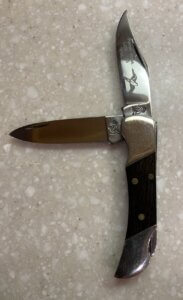 Figure 5. “The Pigeon Hawk” (Model #1205) was also offered from 1982-1992, with the missing ’85-’86 gap, for a total of eight catalog years. It had both the clip blade and spear point blade with each locking. It was the only double lockblade in this small lockback size that Queen ever produced. We think it deserves more credit than it gets. It is not an easy knife to find.
Figure 5. “The Pigeon Hawk” (Model #1205) was also offered from 1982-1992, with the missing ’85-’86 gap, for a total of eight catalog years. It had both the clip blade and spear point blade with each locking. It was the only double lockblade in this small lockback size that Queen ever produced. We think it deserves more credit than it gets. It is not an easy knife to find.
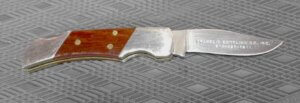
Figure 6. A “Minuteman” as an Special Factory Order (SFO) for advertizing by the local Franklinville Bottling Company, with their phone number. The knife shows minimal polishing and has been used, as would be expected. Still, a very nice free, useful knife. A nice example of the benefits of having a cutlery company nearby. This company is still in business. (Brian Guth photo).
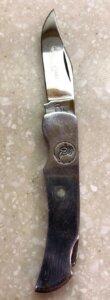 Figure 7. Aluminum small lockback (Model #8455) offered in only 1994-95. (Though you can this blade was made in 1982 and remained in inventory until it was used in this knife with the correct etch.) As with most Aluminum knives, this knife shows more pocketwear, although the blade does not show heavy sharpening or hard use.
Figure 7. Aluminum small lockback (Model #8455) offered in only 1994-95. (Though you can this blade was made in 1982 and remained in inventory until it was used in this knife with the correct etch.) As with most Aluminum knives, this knife shows more pocketwear, although the blade does not show heavy sharpening or hard use.
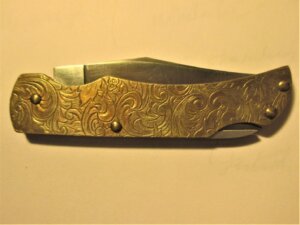 Figure 8. The small lockback in patterned brass “Executive Series” (model #8445E), first offered in 1998 for one year and then renamed “Paladin” Series in 2002-03. This is the thinnest knife Queen ever made with only the decorative liners as the entire handle. It is approximately 5/32” thick and has square edges, so it does not feel very comfortable in my hand. It is my least favorite knife among the Queen small lockbacks. Still, because it was offered for only a few years and collectors appreciate its novelty, it and others in this series, still draws good prices when it shows up in the secondary market. (public Internet photo). To protect the pattern on the handle, the brass pins are left proud. There must be some surface coating that will eventually wear off if the knife is used, so you will find it in bright or oxidized condition, but with blades in generally good shape. In 2013, after Daniels Family took over, the inventory of patterned brass was used as liner material in a series of Mountainman lockback knives in stag or bone covers – that was a beautiful use of this material in our opinion. Small lockback knives were not frequently used as SFO knives in our experience – we certainly have not found many custom club or commercial versions, but the patterned brass has been used several times as shown in Figures 8, 9, and 10.
Figure 8. The small lockback in patterned brass “Executive Series” (model #8445E), first offered in 1998 for one year and then renamed “Paladin” Series in 2002-03. This is the thinnest knife Queen ever made with only the decorative liners as the entire handle. It is approximately 5/32” thick and has square edges, so it does not feel very comfortable in my hand. It is my least favorite knife among the Queen small lockbacks. Still, because it was offered for only a few years and collectors appreciate its novelty, it and others in this series, still draws good prices when it shows up in the secondary market. (public Internet photo). To protect the pattern on the handle, the brass pins are left proud. There must be some surface coating that will eventually wear off if the knife is used, so you will find it in bright or oxidized condition, but with blades in generally good shape. In 2013, after Daniels Family took over, the inventory of patterned brass was used as liner material in a series of Mountainman lockback knives in stag or bone covers – that was a beautiful use of this material in our opinion. Small lockback knives were not frequently used as SFO knives in our experience – we certainly have not found many custom club or commercial versions, but the patterned brass has been used several times as shown in Figures 8, 9, and 10.
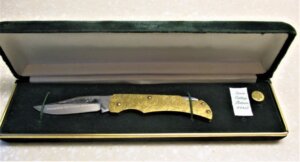
Figure 9. The Pennsylvania Gun Collectors Association 50th anniversary Commemorative was issued in 1998 in a velvet green clamshell with a model number and a brass tie tac made from a Queen inscribed shield. The pile side of the blade has a detailed etch showing a flintlock rifle, powder horn and “possibles” bag, with the model number. (see Figure 10).
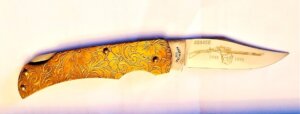
Figure 10. The Pile side of the Pennsylvania Gun Collectors Association 50th Anniversary knife (Figure 9). In our opinion this knife work very well as a “patch knife” that might have been used with a muzzle loading rifle. It is a very attractive commemorative knife package. (Public Internet photo) used so you can get a sense of how different the brass might look on some individual knives.

Figure 11. Servotronics might have gotten a good deal in procuring a knife from one of its cutlery companies. We are not aware of how often the parent company required SFO knives; We have not seen others. There is no date on this knife, but the blade has been polished to a shine and the bright blue etch shows up clearly. This knife might have been used to some extent, because it also shows a darker brass than many we have seen.
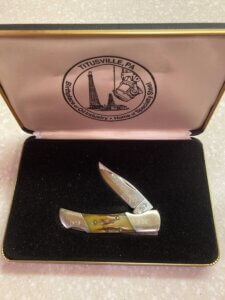 Figure 12. A Titusville Heritage Knife in Commemorative knife in model #8445 small lockback pattern produced for the anniversary of the first oil well beginning the American oil industry in 1859, and the success of Cyclops steel in Titusville. The knife is serialized in an edition of 2000 knives (Sponsored by the Titusville Downtown Business Association). This is the only stag version of a Queen small lockback knife we know of. This knife is rarely seen even though it is a fairly-large edition. Sometimes this knife appears to have a “torched” stag appearance and sometimes almost white stag finish – quite variable but with the same clamshell box showing old well and steel equipment.
Figure 12. A Titusville Heritage Knife in Commemorative knife in model #8445 small lockback pattern produced for the anniversary of the first oil well beginning the American oil industry in 1859, and the success of Cyclops steel in Titusville. The knife is serialized in an edition of 2000 knives (Sponsored by the Titusville Downtown Business Association). This is the only stag version of a Queen small lockback knife we know of. This knife is rarely seen even though it is a fairly-large edition. Sometimes this knife appears to have a “torched” stag appearance and sometimes almost white stag finish – quite variable but with the same clamshell box showing old well and steel equipment.
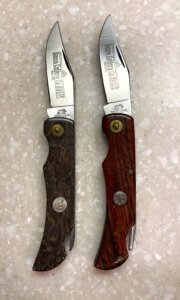 Figure 13. Two wooden handled small lockbacks after the year 2000. The left knife is handled in Birds Eye Maple wood and produced in 2008-09. The right knife is Curly Zebra African hardwood and was made from 2011 – 2014, surviving the change in ownership from Servotronics to Daniels Family Cutlery, making it one of the longest lasting of the “non-Rawhide” small lockbacks knives, fairly-recent, and therefore maybe one of the easiest of this pattern to find. One can easily see the “fisheye” pin and absence of bolster as different from the earlier Minuteman and derived from the mid 90s Rawhide versions (Refer back to Figures 1 and 2.) These knives are a bit wider and more rounded in your hand, are slightly longer than the early versions, and were produced in D2 tool steel, making them the best for any actual cutting one might want among these small lockbacks.
Figure 13. Two wooden handled small lockbacks after the year 2000. The left knife is handled in Birds Eye Maple wood and produced in 2008-09. The right knife is Curly Zebra African hardwood and was made from 2011 – 2014, surviving the change in ownership from Servotronics to Daniels Family Cutlery, making it one of the longest lasting of the “non-Rawhide” small lockbacks knives, fairly-recent, and therefore maybe one of the easiest of this pattern to find. One can easily see the “fisheye” pin and absence of bolster as different from the earlier Minuteman and derived from the mid 90s Rawhide versions (Refer back to Figures 1 and 2.) These knives are a bit wider and more rounded in your hand, are slightly longer than the early versions, and were produced in D2 tool steel, making them the best for any actual cutting one might want among these small lockbacks.

Figure 14. An unusual Queen-made small lockback, with an Ontario Knife company (Franklinville, NY) tang stamp. Both Queen and Ontario were owned by Servotronics and there is considerable evidence they shared administration and innovations in knife production. This knife is very consistent with Queen small lockbacks in every detail except it bears the OK tang stamp, has prominent brass bolsters (while every other Queen knife lockback with bolsters is nickel silver), has big pins, and a different “grainy” type of stabilized wood handles. We have not found it in any OKC catalogs. It might have been a pilot effort to match up with the very popular buck lockback knives which were having great market success. It does not have a sharp blade and little polish. With Queen there are often these little mysteries, but we present them to provide collectors with a framework for evaluating what they might find.
This is a first edition, and there are almost certainly small lockback knives by Queen that we have not found. If you have one, please consider sharing information and photos of it. Thank you. We have attached other references to show more Queen Lockback knives.
References.
Rawhide-10-2019.pdf (queencutleryguide.com)
Birds-Eye-Maple-10-2019.pdf (queencutleryguide.com)
Aluminum-10-2019.pdf (queencutleryguide.com)
Genuine-Bone-10-2019.pdf (queencutleryguide.com)
Curly-Zebra-10-2019.pdf (queencutleryguide.com)
Executive-Paladin-10-2019.pdf (queencutleryguide.com)
Hawk-Rawhide-lockbacks-review-8-2019.pdf (queencutleryguide.com)
Queen Midsize Lockback knives – Queen Cutlery Guide
Queen-Button-Lock-Knives-revised-2023.pdf (queencutleryguide.com)
Queen-41L-Mini-Hunter-1-3-2023.pdf (queencutleryguide.com)
Queen-06L-teardrop-liner-lock-1-4-2023.pdf (queencutleryguide.com)

